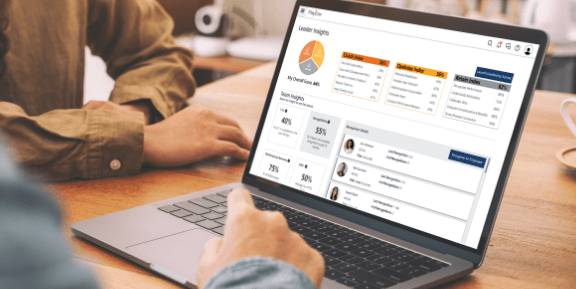Everyone wants to be good at their job. But, despite HR’s best efforts, some workers are bound to run into performance issues. It’s easy to get frustrated when that happens – especially if their performance impacts the rest of the team.
Performance improvement plans (PIPs) allow managers to support struggling employees and still hold them accountable. They’re also a key method of protecting your company from compliance issues. No matter which department the employee works for, HR should take an active role in implementing performance improvement plans.
What is a Performance Improvement Plan (PIP)?
A performance improvement plan is a formal process used to address and improve an employee’s performance. PIPs are typically initiated by the employee’s direct supervisor with support from HR. These plans set clear expectations for how the employee needs to improve, including a timeline, check-ins, and a plan for providing feedback. By documenting every step of the process, HR can set the stage for whatever comes next, whether or not the employee stays with your company when their performance improvement plan ends.
Reason a Performance Improvement Plan is Used
Employee performance improvement plans can address a wide variety of issues, including but not limited to poor quality of work, attendance problems, behavioral issues, and the failure to meet deadlines. PIPs should not be implemented as a punishment. Instead, managers should frame them as an opportunity for employees to get support and improve their performance at work, ultimately growing their careers.
Benefits of a Performance Improvement Plan
PIPs have several benefits for employees, employers, and the company at large. Struggling workers can receive valuable support and feedback in a more structured way, which helps them learn new skills and develop better processes for completing their tasks. This process can also include additional learning opportunities and on-the-job training.
One employee’s improvements have a direct impact on their peers, streamlining workflows for everyone on the team. Performance improvement plans can also ease managers’ frustration and help them work toward company goals. From an HR perspective, PIPs reduce turnover, improve employee engagement, and protect the company from potential compliance issues should the employee be terminated.
Determining if an Employee Performance Improvement Plan is Needed
When determining if it’s time to implement a performance improvement plan, managers and HR leaders should strive to be as objective as possible. This should never be an emotional decision. The employee’s manager should have clear, specific concerns about the person’s performance. Instruct them to document as much information as possible, including any missed deadlines, instances of behavioral issues, dates of their absences, and so on.
If you’re wondering whether it’s time to implement a PIP, start by answering these questions:
- Is the employee meeting clearly defined expectations?
- Do they consistently follow company policy?
- Are they performing all their job duties?
- Do they routinely miss deadlines?
- How often do they have unplanned or unexplained absences?
- Does the employee consistently deliver results/meet quotas?
- How often do other team members have to take on the employee’s work?
- Have other employees or customers registered any formal complaints about the employee’s behavior? If so, have those complaints been resolved?
- How, if at all, has the employee’s performance negatively impacted the business as a whole?
Work with the employee’s direct supervisor to answer these questions and determine whether a PIP is necessary.
The Role of HR Leaders in Performance Improvement Plans
HR plays a major role in the PIP process. Your team will have a hand in the administration of every performance improvement plan, no matter which employee and manager are involved. These are some of HR’s key responsibilities in the implementation of PIPs.
Create a Process for Performance Improvement Plans
HR is responsible for designing a company-wide process to implement PIPs. They should define the criteria for deciding a PIP is necessary, create all the forms a manager will need, and suggest a timeline. HR should also designate a point person to support managers and employees during the PIP process.
Train Managers
All your managers should understand how to use a performance improvement plan long before it becomes necessary. HR should lead training sessions for managers and directors as part of their onboarding or promotion process.
Share Relevant Documents
HR leaders should keep blank versions of any forms related to performance improvement plans. Those could include form letters or emails to notify employees they’ll need to begin a PIP, an outline of a sample performance improvement plan, a series of email templates to remind employees of upcoming performance review dates, and so on.
Document Progress
Make sure you keep detailed records of the employee’s progress every step of the way. HR can also take note of the managers’ impressions and any relevant conversations you have with other company leaders. Whenever possible, include dates and times. This documentation can protect your company from any potential compliance issues in the future.
Communicate Results
While PIPs are intended to help employees grow, they can also result in termination. Either way, HR should be prepared to communicate the results of the performance improvement process. In some situations, you’ll just need to recap the process with the employee and their manager. If the employee fails to improve, however, you might need to begin the offboarding process.
Performance Improvement Plan Best Practices
Performance improvement plans can be extremely complex, both emotionally and logistically. HR leaders can use these best practices to streamline the process and protect against potential complications.
Provide Clear Communication
Make sure everyone understands how performance improvement plans work at your company, including managers and the employee in question. Employees should clearly understand how their performance needs to improve, what timeline they need to follow, and the consequences of failing to meet expectations. Deadlines should never come as surprises.
Set Realistic Goals
Remember that improvements take time. No employee can change their entire approach to work overnight. Work with managers to set small, short-term goals that support long-term objectives. Reaching these milestones can motivate the employee to continue improving.
Provide Realistic Timelines
Performance improvement plans should include realistic, achievable timelines. The goal is to hold the employee accountable to a high standard without being unfair. The timeline should be long enough to allow the employee to make meaningful progress, but not so long that it becomes a burden.
Give Support
By the time you implement a performance improvement plan, the employee is already facing problems at work – possibly because of the stress of the job or other issues in their personal life. Either way, they’re already having a hard time. HR should strive to be as compassionate and supportive as possible throughout the process, offer positive reinforcement, and encourage the employee to do their best.
Performance Improvement Plan FAQs
1. How long is a performance improvement plan?
A performance improvement plan typically lasts 30-90 days, but it can vary depending on the severity of the performance issues and the company’s policy.
2. Who typically receives a performance improvement plan?
Employees who are struggling to meet expectations or have violated company policy may be placed on a performance improvement plan.
3. What are the disadvantages of a performance improvement plan?
Performance improvement plans can be stressful for both managers and employees. Without proper workflows, they can also be time-consuming and difficult to implement.
4. Are performance improvement plans bad?
Performance improvement plans are a sign that the employee is struggling. However, they’re also an opportunity for people to receive more support as they learn and grow. Ideally, PIPs should increase accountability and inspire employees to do their best.
5. Is a PIP a step toward termination?
A performance improvement plan can be a step toward termination, but that’s not always true. If an employee meets or exceeds the expectations outlined in the PIP, termination should become unnecessary. The best outcome is for the employee’s performance to improve and for them to stay with the company.
How Paycor Can Help with Performance Improvement Plans
Administering PIPs is a key HR process. While managers are responsible for setting expectations and employees take the lead on improving their performance, HR should guide both parties through the process. Paycor’s HR software streamlines every aspect of HR administration. Our Talent Development software empowers leaders to evaluate their employees’ productivity, potential, and progress toward agreed-upon goals.
Implementing a performance improvement plan can have a major impact on an employee’s career. Managers shouldn’t take this process lightly. However, PIPs aren’t always a negative – in many cases, they empower the employee to learn more and do better at work. When someone on your team is struggling, performance improvement plans allow HR to support both managers and employees while continuing to drive business results.









